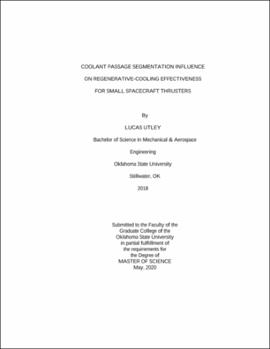| dc.description.abstract | The purpose of this thesis is to examine the effect of varying the number of cooling passages in a regeneratively-cooled rocket combustion chamber and nozzle analog for a small spacecraft thruster producing 22N (5lbf) thrust. Most chemical rocket satellite thrusters are radiation-cooled and utilize toxic monopropellant hydrazine, but the emergence of low-toxicity, higher-performance green propellants is reducing system costs of pre-launch loading procedures. Due to their high water content, green propellants necessitate large on-board power requirements to ignite. Additionally, they burn at elevated flame temperatures compared to conventional hydrazine, requiring more exotic refractory metals to comprise the catalyst bed and thrust chamber for withstanding decomposition temperatures. By utilizing regenerative cooling, not only can the propellants become preheated, thereby reducing ignition power requirements, but the lower thrust chamber temperatures maintained allow for less expensive metal alloys. In this study, additive manufacturing was used for developing the thrust chamber, and atomic diffusion additive manufacturing formed the stainless steel test hardware. Testing involved firing solid propellant rocket motors as a gas generator to replicate elevated-pressure, high-temperature environments characteristic of chemical rocket propulsion systems to understand thermal changes in the coolant flow and nozzle surface temperatures. A single annular cooling passage was segmented by 4, 8, and 12 walls to determine cooling effectiveness for each configuration by measuring water coolant temperature rise and external surface temperature at the nozzle throat. An analytical heat transfer model was also developed to calculate these temperatures and heat flux for comparison to the experimental study. Results indicate that fewer, wider cooling passages were more effective at cooling the thrust chamber, with a single, unsegmented annulus being the most effective for heat transfer to the cooling fluid. A single cooling passage resulted in 55% cooling effectiveness, while 12 segmented passages had just 46%. By integrating few cooling passages in junction with additive manufacturing for small-scale rocket thrust chambers, higher flame temperatures may be sustained, and favorable potential is shown for utilizing non-refractory alloys with green propellants to achieve lower costs for in-space propulsion systems. | |
